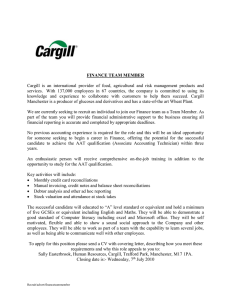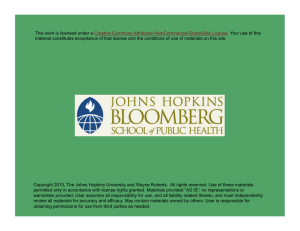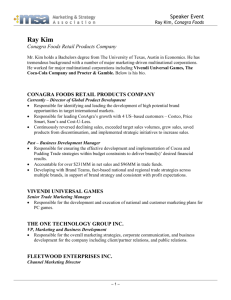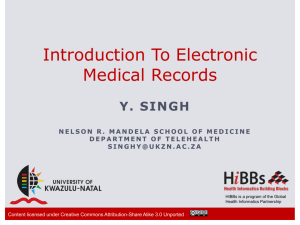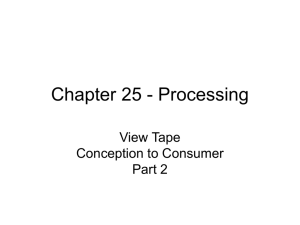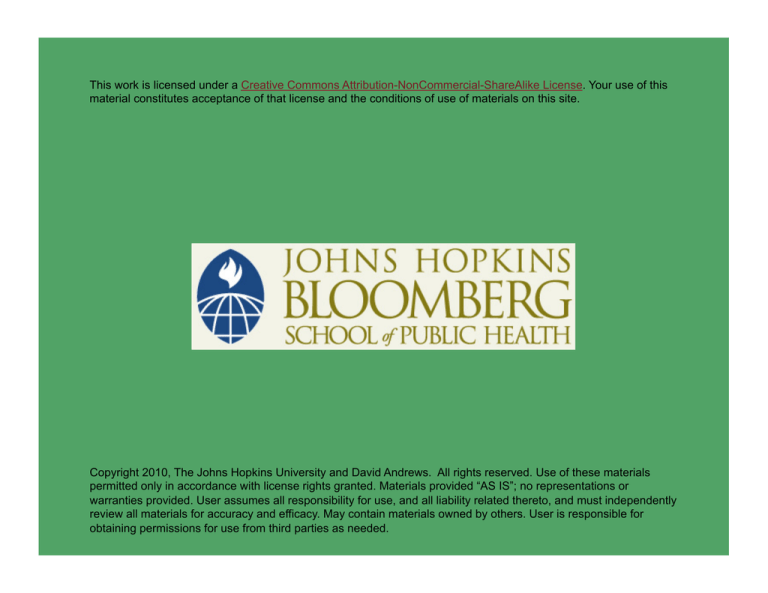
This work is licensed under a Creative Commons Attribution-NonCommercial-ShareAlike License. Your use of this
material constitutes acceptance of that license and the conditions of use of materials on this site.
Copyright 2010, The Johns Hopkins University and David Andrews. All rights reserved. Use of these materials
permitted only in accordance with license rights granted. Materials provided “AS IS”; no representations or
warranties provided. User assumes all responsibility for use, and all liability related thereto, and must independently
review all materials for accuracy and efficacy. May contain materials owned by others. User is responsible for
obtaining permissions for use from third parties as needed.
Section B
Food Production and Food System Issues to Consider
What’s Happening to Farm Income?
Photo by Dabe via flickr.com. Creative Commons BY-NC-SA.
3
What’s Happening to Farm Workers?
Photo by farlane via flickr.com. Creative Commons BY-NC.
4
The U.S. Food System Is Like an Hourglass
Photo by bogenfreund via flickr.com. Creative Commons BY-SA.
Crops and livestock produced by
farm workers, farmers, and
ranchers are funneled into the
grip of a handful of firms
These firms control both the
processing and distribution of
food and fiber to millions of
consumers around the world
5
Capturing the Retail Food Dollar
6
A Different Way of Looking at the Food Pyramid
Monsanto,
Novartis
ConAgra,
Philip Morris
DuPont
Tyson, IBP
Nestle
ADM
7
Top 10 Retailers: 24% of Market Share
Top 10 food retailers by market share, 2004
- Wal-Mart, 8%
- Carrefour, 3%
- Metro-AG, 2%
- Ahold, 2%
- Tesco, 2%
- Kroger, 2%
- Costco, 2%
- ITM, 1%
- Albertsons, 1%
- Edeka Zentrale, 1%
Source: ETC Group.
8
Global Area of Biotech Crops
Global area of biotech crops increased by 11% (9 million hectares or
22 million acres) between 2004 and 2005 (Source: Clive James,
2005)
Monsanto is exploring acquisition of Delta and Pine Land
9
Power Shift in the Supply Chain
Retailers, not farmers, dominate supply
Consumers
Customers
Outlets
Supermarket formats
POWER
Buying Desk
Manufacturers
Semi-manufacturers
Suppliers
Farmers/Producers
Adapted from Grievink. (2003). Cap Gemini, OECD. (From Tim Lang).
10
Happy Companies
Photo by J. Star via flickr.com. Creative Commons BY-NC-SA.
11
Global Expansion of Transnational Supermarkets
Global expansion of transnational supermarkets
- Carrefour (France)
- Ahold (Netherlands)
- Metro (Germany)
- Walmart (USA)
- Tesco (UK)
12
Top 10 Food and Beverage Corporations, 2004
Food and beverage revenue
in millions of U.S. dollars
Total revenue
in millions of U.S. dollars
1. Nestle
$63,575
$69,862
2. Archer Daniels Midland
$35,944
$35,944
3. Altria Group
$69,963
$32,168
4. PepsiCo
$29,261
$29,261
5. Unilever
$29,205
$52,267
6. Tyson Foods
$26,441
$26,441
7. Cargill
$24,000
$62,907
8. Coca-Cola
$21,962
$21,962
9. Mars, Inc.
$18,000
$18,000
$17,040
$17,040
Company
10. Groupe Danone
Source: Global Food Markets (GFM), Leatherhead Food International.
13
Concentration in Protein
Beef packers CR4 = 81%
1. Tyson (IBP, Inc.)
2. Cargill (Excel)
3. Swift & Co. (ConAgra)
4. Farmland National Beef
Pork packers CR4 = 59%
1. Smithfield
2. Tyson (IBP, Inc.)
3. ConAgra (Swift)
4. Cargill (Excel)
Broilers CR4 = 50%
1. Tyson Foods
2. Gold Kist
3. Pilgrim’s Pride
4. ConAgra
Source: Hendrickson and Heffernan.
CR4 = “Four-Firm
Concentration Ratio”—a
measure of the total market
share of the four largest
firms in an industry
14
Grains and Milling
Terminal grain handling
facilities CR4 = 60%
- Cargill
- Cenex Harvest States
- ADM
- General Mills
Flour milling CR4 = 61%
Soybean crushing CR = 80%
Source: Hendrickson and Heffernan.
Exporters?
Cargill, ADM, Zen-Noh
- Export 81% of U.S. corn and
65% of U.S. soybeans
ConAgra
Bunge
Bunge, ADM, and
Cargill have 64% of
soybean oil
processing in Brazil
15
Concentration in Seed Industry
Company
2006 Seed Sales
(US $ millions)
Monsanto (US)
$4,028
Dupont (US)
$2,781
Syngenta (Switzerland)
$1,743
Groupe Limagrain (France)
$1,035
Land O’ Lakes (US)
$756
KWS AG (Germany)
$615
Bayer Crop Science (Germany)
$430
Delta & Pine Land (US) – Acquisition by Mansanto pending
$418
Sakata (Japan)
$401
DLF-Trifolium (Denmark)
$352
Source: ETC Group. (April 30, 2007).
16
Net Market Income, Dollars per Farm
Corporate profits rise
Farm profits fall
17
Overweight among Children and Teenagers
18
Gap Between Health and Advertising Reality
Television advertising
- Fatty & sugary foods
- Mainly confectionary, highly sugared breakfast cereals,
prepared foods, and fast food restaurant meals
19
Growth of Total Meat Consumption
Annual growth of total meat consumption, by region, 1982–2020
Total meat consumption for 1983 and 1993 are three-year
moving averages. The 2020 projections come from IFPRI's
global model, IMPACT.
Sources: FAO; IFPRI; Outlook on agriculture, 30, 28.
20
Kroger Co.
Subsidiaries
Processor
Cargill/Monsanto
Beef
Retailer
Kroger Co.
Source: Hendrickson, Mary.
Fred Meyer (1998)
Quality Food Centers
Hughes Markets, Inc.
Keith Uddenberg, Inc.
Ralph’s/Food 4 Less
Smith’s
Dillions
Gerbes
King Soopers
Jay C Food Stores
Foods Co.
Cala Foods/Bell Markets
Owen’s
Hilander
Fry’s
City Market
PriceRite
Kessel
Payless
21
Wal-Mart
Operations in:
Processors:
Tyson Foods (IBP)
Farmland Foods
Smithfield
Poultry
Beef
Pork
Retailer:
Wal-Mart
Source: Hendrickson, Mary.
United Kingdom (#3)*
Asda
Germany
Spar Handels
Wertkauf
Argentina
Brazil
Canada
Mexico
China
Korea
United States (#2)*
22
Two Food Systems
There are two types of food systems in today’s world
1. Industrial food systems—based on production of quantity and
efficiency
2. Sustainable or ecological food systems—based on ecological,
economic, social, cultural, and just approaches in an “integral
bottom line” based on production of quality
These systems are already competing for eaters’ allegiance
23
Food Disparagement Laws
State civil and criminal statutes
- Statutory food-disparagement laws have been enacted in 13
states
- Twelve of these statutes are civil, one is criminal (Colorado)
- These laws have not been tested constitutionally, but in Texas
this was the basis of the lawsuit involving Oprah Winfrey
24
Pro Diversified Family Farm Laws
Anti-corporate farming laws in Iowa, Minnesota, North Dakota,
South Dakota, and Nebraska are being challenged successfully by
Smithfield et al.
These laws are meant to support independent family farmers in a
diversified and localized family-based farm system
25
Laws Curtailing Local Control Over Seeds
In 2005, state legislatures increasingly attempted to preempt, or
disallow, local and county initiatives that were mostly aimed at
limiting or prohibiting genetically modified (GM) seeds and crops, 19
states passed such laws
26
Preemption of Local Control of Factory Farms
A number of states, such as Iowa, have taken the capacity away
from counties to site or zone for factory farms
- Some communities are trying to find ways around the laws in
health ordinances, but not very successfully
Some counties are requiring that organic produce be used in county
institutions, e.g., Woodbury County, Iowa
27
The World Trade Organization
Photo by Jackson Lee via flickr.com. Creative Commons BY-NC-SA.
28
Pushing Production for Export
Global call for export production
Produce as much as you can
World Bank and IMF require countries to decrease social programs
and increase agricultural export
29
Community Voices
Photo by sgrah via flickr.com. Creative Commons BY-NC-SA.
30


